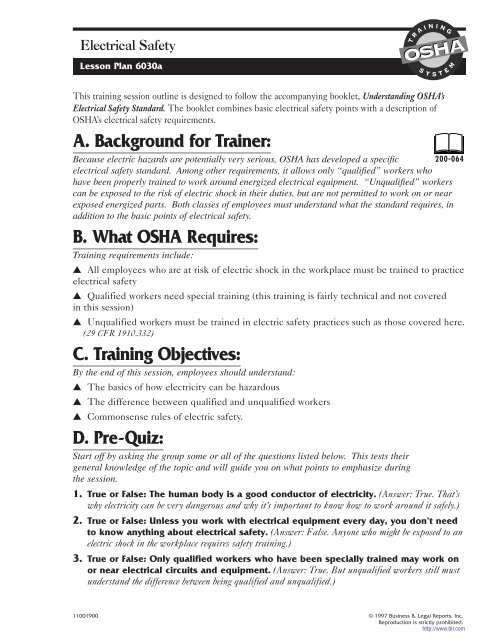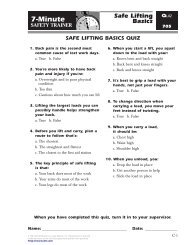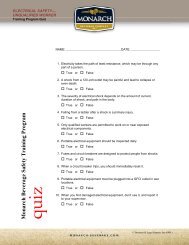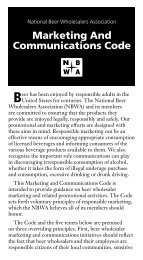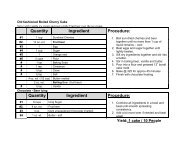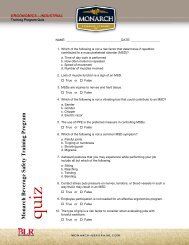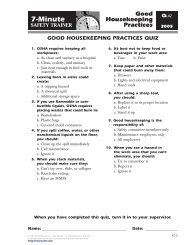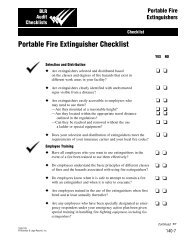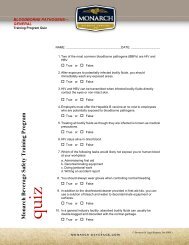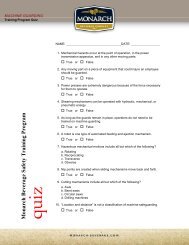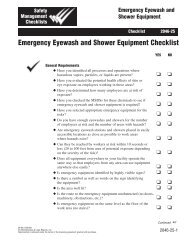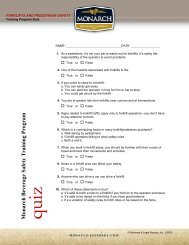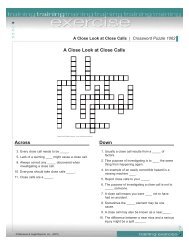Electrical Safety Trainer - Monarch Beverage
Electrical Safety Trainer - Monarch Beverage
Electrical Safety Trainer - Monarch Beverage
Create successful ePaper yourself
Turn your PDF publications into a flip-book with our unique Google optimized e-Paper software.
<strong>Electrical</strong> <strong>Safety</strong><br />
Lesson Plan 6030a<br />
OSHA<br />
T R A<br />
S<br />
I N<br />
Y<br />
S<br />
I N G<br />
E<br />
T<br />
M<br />
This training session outline is designed to follow the accompanying booklet, Understanding OSHA’s<br />
<strong>Electrical</strong> <strong>Safety</strong> Standard. The booklet combines basic electrical safety points with a description of<br />
OSHA’s electrical safety requirements.<br />
A. Background for <strong>Trainer</strong>:<br />
Because electric hazards are potentially very serious, OSHA has developed a specific<br />
electrical safety standard. Among other requirements, it allows only “qualified” workers who<br />
have been properly trained to work around energized electrical equipment. “Unqualified” workers<br />
can be exposed to the risk of electric shock in their duties, but are not permitted to work on or near<br />
exposed energized parts. Both classes of employees must understand what the standard requires, in<br />
addition to the basic points of electrical safety.<br />
B. What OSHA Requires:<br />
Training requirements include:<br />
▲ All employees who are at risk of electric shock in the workplace must be trained to practice<br />
electrical safety<br />
▲ Qualified workers need special training (this training is fairly technical and not covered<br />
in this session)<br />
▲ Unqualified workers must be trained in electric safety practices such as those covered here.<br />
(29 CFR 1910.332)<br />
C. Training Objectives:<br />
By the end of this session, employees should understand:<br />
▲ The basics of how electricity can be hazardous<br />
▲ The difference between qualified and unqualified workers<br />
200-064<br />
▲ Commonsense rules of electric safety.<br />
D. Pre-Quiz:<br />
Start off by asking the group some or all of the questions listed below. This tests their<br />
general knowledge of the topic and will guide you on what points to emphasize during<br />
the session.<br />
1. True or False: The human body is a good conductor of electricity. (Answer: True. That’s<br />
why electricity can be very dangerous and why it’s important to know how to work around it safely.)<br />
2. True or False: Unless you work with electrical equipment every day, you don’t need<br />
to know anything about electrical safety. (Answer: False. Anyone who might be exposed to an<br />
electric shock in the workplace requires safety training.)<br />
3. True or False: Only qualified workers who have been specially trained may work on<br />
or near electrical circuits and equipment. (Answer: True. But unqualified workers still must<br />
understand the difference between being qualified and unqualified.)<br />
11001900 © 1997 Business & Legal Reports, Inc.<br />
Reproduction is strictly prohibited.<br />
http://www.blr.com
OSHA<br />
T R A<br />
S<br />
I N<br />
Y<br />
S<br />
I N G<br />
E<br />
T<br />
M<br />
<strong>Electrical</strong> <strong>Safety</strong><br />
Lesson Plan 6030b<br />
E. Session Outline:<br />
General Training Point: This session should make clear that electricity can be extremely<br />
hazardous, and that employees should take OSHA’s and your company’s electrical safety rules very seriously.<br />
1. Electricity and Its Dangers<br />
a. Electric shocks kill and injure many workers every year<br />
i. Caused by unsafe conditions or unsafe acts<br />
ii. OSHA and this organization have rules to help prevent tragedies<br />
b. How electricity works<br />
i. Travels through conductors (wires and cables)<br />
ii. Conductors should be insulated with non conducting material<br />
iii. Most electrical equipment is grounded to make sure current passes safely<br />
to the ground, instead of through the human body.<br />
2 3<br />
200-064<br />
Training Tip: Use an actual accident or near-miss involving electricity in your workplace to illustrate the<br />
hazards. Emphasize that the human body is a good conductor of electricity.<br />
2.<br />
4<br />
Qualified and Unqualified Workers<br />
200-064<br />
a. Qualified workers are permitted to work around energized (“live”) electrical parts<br />
because of special training.<br />
b. Unqualified workers may not work around energized equipment, but still could be<br />
exposed to electric shock hazards. They need to know hazards and safety procedures.<br />
Training Tip: Point out that no one is considered qualified unless he or she has been formally trained and<br />
designated as such by your company or employer.<br />
3.<br />
5<br />
Basic Points of <strong>Electrical</strong> <strong>Safety</strong><br />
200-064<br />
Handout: Distribute copies of Handout #1, or use as an overhead slide, especially<br />
if you are not using the training booklet. If using the training booklet, either use the<br />
handout here or review it at the end of the session.<br />
a. Only qualified workers can work around energized equipment<br />
b. De-energize circuits, lock out and tag out before working on them<br />
c. Stay away from overhead power lines<br />
d. Use PPE and insulated tools<br />
e. Follow safety rules with portable electrical equipment (power tools)<br />
f. Obey warning signs<br />
g. Be careful in “blind” areas not to touch live wires.<br />
Training Tip: Have one or more members of the group read each safety tip from the list on page 5 of the booklet.<br />
11001900 © 1997 Business & Legal Reports, Inc.<br />
Reproduction is strictly prohibited.
<strong>Electrical</strong> <strong>Safety</strong><br />
Lesson Plan 6030c<br />
OSHA<br />
T R A<br />
S<br />
I N<br />
Y<br />
S<br />
I N G<br />
E<br />
T<br />
M<br />
4. Lockout and Tagout<br />
a. Qualified worker must disconnect, lock out and tag out equipment before<br />
working<br />
6 7<br />
b. The same qualified worker must re-connect equipment after work is finished, following<br />
proper safety procedures<br />
c. In some cases, locks can be used without tags or vice versa. You must get management<br />
approval in those cases!<br />
Training Tip: If the group has not already had lockout/tagout training, the important point to emphasize is that<br />
only qualified workers may do it. If the group already understands lockout/tagout, the details on<br />
these pages will be more meaningful. Ask workers why they think lockout/tagout is so important.<br />
5.<br />
8 9<br />
Other <strong>Safety</strong> Procedures<br />
200-064<br />
a. Hazard warning signs and tags, barricades, attendants keep unqualified workers<br />
away from work areas<br />
b. Sometimes qualified workers must work on “live” circuits, such as when circuits need<br />
to be tested.<br />
Training Tip: Emphasize that Unqualified workers should obey any warnings and stay well away from areas<br />
where live equipment is being worked on.<br />
6. Hazards of Overhead Power Lines<br />
a. Unqualified workers must stay at least 10 feet away—including any<br />
conducting tools<br />
b. Qualified workers must use the right PPE, insulated tools<br />
c. Vehicles must stay at least 10 feet away, or have proper insulated barriers<br />
d. Workers on the ground should not contact vehicles or equipment unless properly<br />
protected.<br />
Training Tip: Emphasize the “10 foot” rule. Make sure the group understands that it applies to tools,<br />
and that they know what types of tools can conduct electricity.<br />
7.<br />
12<br />
Insulated PPE and Equipment<br />
a. Non metal PPE—hats, earmuffs, goggles, shields<br />
b. Insulated tools and handling equipment<br />
c. PPE and equipment must be used properly and be in good condition, or it won’t work.<br />
Training Tip: Show examples of the non metal PPE and insulated tools used in your workplace.<br />
Ask workers why only approved equipment can be used.<br />
200-064<br />
10 11<br />
200-064<br />
200-064<br />
11001900 © 1997 Business & Legal Reports, Inc.<br />
Reproduction is strictly prohibited.
OSHA<br />
T R A<br />
S<br />
I N<br />
Y<br />
S<br />
I N G<br />
E<br />
T<br />
M<br />
<strong>Electrical</strong> <strong>Safety</strong><br />
Lesson Plan 6030d<br />
8. Preventing Electric Shocks<br />
a. Careful in “blind” areas and confined spaces—don’t touch live wires<br />
b. Insulate or guard long conducting objects (like pipes and tools) when working near<br />
energized equipment<br />
c. Ladders should be non conducting (non metal)<br />
d. Don’t wear metal objects (watches, belt buckles, rings, etc.)<br />
e. Follow label and MSDS precautions around flammable liquids.<br />
13<br />
200-064<br />
Training Tip: To make sure they understand these rules, ask the group what might happen if these rules<br />
are not followed.<br />
9. Portable <strong>Electrical</strong> Equipment (Power Tools)<br />
a. DO: Make sure tools are not damaged, use the right tool for the conditions<br />
b. DON’T: Misuse or damage cords, use when wet (unless insulated)<br />
14<br />
200-064<br />
Training Tip: Ask the group which of the “Do’s” and “Don’ts” on this page they think are most important.<br />
10.<br />
15<br />
Conclusion: Treat <strong>Electrical</strong> Equipment with Respect<br />
200-064<br />
a. Leave electrical jobs to qualified workers<br />
b. Stay at least 10 feet from power lines<br />
c. Obey electrical hazard warnings<br />
d. Follow all electrical safety rules<br />
e. Respect and follow lockout/tagout procedures.<br />
Handout: If you have not already used it in the session, distribute copies of Handout<br />
#1, which summarizes the key points. You may also want to use the handout as an<br />
overhead slides to review these points.<br />
F. Quiz:<br />
Have the group take the Quiz included as Handout #2 in this Chapter. Distribute copies as a written<br />
quiz, or use as an overhead slide for general discussion. Correct answers are given below.<br />
<strong>Electrical</strong> <strong>Safety</strong> Quiz: Answer Key<br />
1. True.<br />
2. False. Qualified workers must have special training.<br />
However, unqualified workers may still be exposed to electric shock hazards.<br />
3. True.<br />
4. False. All Unqualified workers must obey warning signs and barriers.<br />
5. True.<br />
11001900 © 1997 Business & Legal Reports, Inc.<br />
Reproduction is strictly prohibited.
<strong>Electrical</strong> <strong>Safety</strong><br />
Lesson Plan 6030e<br />
OSHA<br />
T R A<br />
S<br />
I N<br />
Y<br />
S<br />
I N G<br />
T<br />
M<br />
E<br />
6. True.<br />
7. False. A metal hard hat can conduct electricity; it should be non metal.<br />
8. True. They can conduct electricity into the body.<br />
9. False. A damaged cord should never be used.<br />
10. True.<br />
G. Wrap-up<br />
▲ Ask for any final questions.<br />
▲ Distribute the Training Session Attendance Form, and have the group sign and return it.<br />
▲ Thank the group for their attention.<br />
11001900 © 1997 Business & Legal Reports, Inc.<br />
Reproduction is strictly prohibited.


